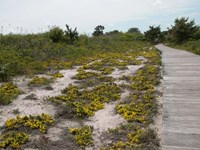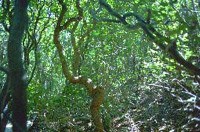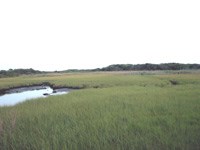The plant life of Fire Island is diverse and reflects the great variation in such environmental factors as wind, salinity, the availability of soil moisture,and the extent of human activity. Many habitats, like the beach and primary dune face, are so severe that only a few plant species can survive. However, just a few feet away in a more protected habitat, many species may thrive.
When the park was surveyed in 1971 and 1974, fourteen major vegetation types or subtypes were identified on Fire Island. These included the beach grass grasslands, beach heather and bearberry dwarf scrubs, thickets, pitch pine woodland, broadleaf forest, and a variety of wetlands and salt marsh. Vegetation recorded at that time for the William Floyd Estate included upland forests, lowland forests, thickets, upland meadow, cultivated fields, residential land, common reed grassland, and tidal marsh.
In recent years, more advanced classification and recording systems have been adopted to help us better understand plant species associations. More than 30 vegetation associations were mapped for Fire Island National Seashore by 2002.
At least 237 plant species have been identified within the Seashore. The casual observer, however, may only be interested in knowing a few of the most obvious plants.






